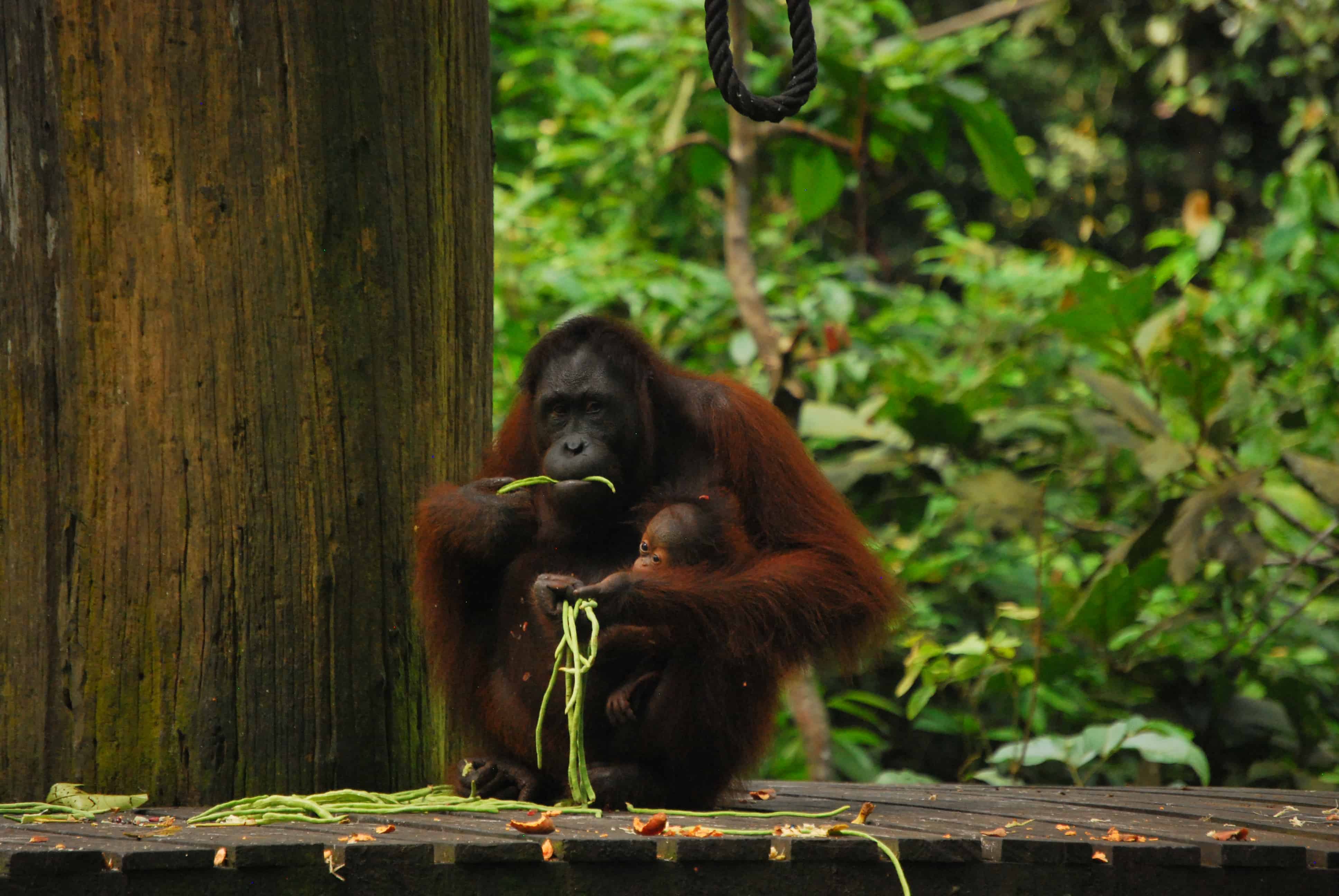
I’d been fortunate.
Less than 24 hours after arriving in the rainforest of Malaysian Borneo, I’d already spotted six wild orang-utans. The first clutched to the top of a ficus tree alongside the Kinabatagan River, silhouetted in the distance as we passed by in our boat. The next five were much closer, swinging overhead in a verdant jungle canopy as we hiked toward Gomantong Caves. But these ephemeral encounters with the “man of the forest” left me with a thirst to further understand the nature of Borneo’s famous great apes, and, in some small way, I hoped to contribute to the conservation of these at-risk primates.

Sepilok Orang-utan Rehabilitation Centre promised to add education to my experience. Located in Northwest Borneo, Sepilok stewards 43-square-kilometres of virgin lowland equatorial rainforest dedicated to the rescue, rehab and, when possible, release of orang-utans. About 150 to 200 apes live onsite — the number isn’t concrete as some wild orang-utans have migrated into the preserve, and other rehabbed apes have simply vanished into the jungle to live normal lives, never again to return to Sepilok’s feeding platforms. It is no zoo. Visitors should attend during scheduled feeding times if they hope to see an ape, otherwise an orang-utan sighting could be as rare as anywhere else in Borneo.

Originally founded in 1964, Sepilok is today run by the Sabah Wildlife Department for purposes of not only conserving these apes, but to educate Borneans on the plight of their native orang-utan. In crisis due to habitat loss — primarily because of palm oil plantations — orphaned or injured orang-utans are rescued (often due to tips from the public) and rehabbed mostly by volunteers. Educational outreach is an important aspect to this program — teaching locals how to respond to a sighting of an orphaned or injured ape so it can receive immediate care.
Onsite, young apes are taught to climb, to feed, to nest — duties normally performed by their mothers — and ideally, some will be re-wilded. As the centre proclaims: “To simply rehab an orang-utan does nothing, we must rehab and release these animals to actually help the population.” But the process of rearing a young orang-utan can take six years or more. And six years of specialized care takes big influxes of cash.

We start our tour with an informative video, then wander along a boardwalk to view the 10:00 a.m. feeding. I gather with a crowd of 30-or-so others to watch patiently as a parks staffer hauls a basket of fruit, veggies and greenery to an elevated platform some five metres beyond the boardwalk. (Ideal for wildlife photographers with a 200mm lens.) Breakfast bell rung, ginger-tinted orang-utans — as well as the occasional cheeky macaque — show up to chow down. It lacks the magic of a wild encounter, but makes up for this with an up-close, sustained observation opportunity.

A momma feeds a baby clutched tightly to her bosom, who, in turn, occasionally looks toward us, bug-eyed and curious. The mother is calm, accustomed to her attention; her sombre face is that of an elder. And their arms are incredible — some orang-utans have eight-foot spreads; full-grown orang-utans have the strength of four men. Soon, a younger, more bashful ape swings in arm-over-arm on the ropes leading to the platform. He grabs a handful of bananas and carrots, and then lurches away to eat them in privacy behind a hardwood tree. We’re told they share 96 per cent of our DNA — and this remarkable close-encounter with these human-like creatures leaves little doubt.
Touched by the experience and by the good work done here, I adopt a young ape named Gelison on the way out— a symbolic program soliciting donations to assist in the centre’s operations — won over by his messy hair and goofy grin. I think I saw 96 per cent of myself.
Discover More: orangutan-appeal.org.uk/about-us/sepilok-rehabilitation-centre

They Only Come Out at Night
Pit vipers, tree-hole frogs, flying squirrels, scorpions, praying mantis and poisonous caterpillars? It’s not as scary as it sounds. Scored by a soundtrack of giant cicadas and illuminated by fireflies, a nighttime tour of Sepilok is fascinating way to see the flipside of Borneo, when apes sleep and creepy-crawlies rule the forest.

Sun Bears
Located next-door to Sepilok, the Bornean Sun Bear Conservation Centre allows guests to get a look at the smallest sub-species of the world’s smallest bear: the East Malaysian sun bear. Learn about these gorgeous, at-risk creatures while snapping photographs from an elevated viewing platform. sunbears.wildlifedirect.org
If You Go
A visit to Sepilok Orang-utan Rehabilitation Centre is included in G Adventure’s Borneo-Sabah Adventure. (gadventures.com)


